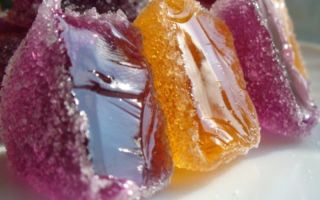Content
- 1 What is marmalade and what is it made of
- 2 The chemical composition of marmalade
- 3 How many calories in marmalade
- 4 Why is marmalade useful?
- 5 The benefits of marmalade for women
- 6 Can marmalade be used during pregnancy and breastfeeding?
- 7 How and at what age to give marmalade to children
- 8 Is marmalade useful for losing weight
- 9 Is marmalade possible for diabetes
- 10 The use of marmalade for gastritis and pancreatitis
- 11 How much marmalade per day
- 12 How to make homemade marmalade
- 13 Why marmalade is harmful: contraindications
- 14 How to choose and store marmalade
- 15 Conclusion
The benefits and harms of marmalade lie in its sweetness - where there are a lot of sugars, there is harm, but for the most part gelatin is present in the composition. It does not pose any particular harm to the body, despite the dyes and flavor enhancers. Blanks are used to create forms. And to make it of different consistency and density, add some more ingredients.
What is marmalade and what is it made of
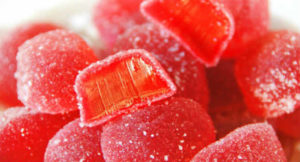
A dessert portion of delicacies is a harmless product consisting of gelatinous components with added sugars and color pigments. It is prepared on a conveyor belt with the addition of gelatin and gelling agents like agar-agar and pectin. Useful properties of marmalade are in its composition and properties.
Gelatin is an animal useful product - processed animal cartilage, and pectin is of vegetable nature. Both substances are useful, since pectin, obtained artificially in the production from fruit and citrus juices, is not absorbed by the body, but is excreted. He takes with him toxins and harmful substances, such as toxins.
This is not the whole structure of the delicacy, which is so familiar from childhood. Agar-agar is obtained from algae, but is rarely added to the dessert, because the product is too expensive and expensive in terms of extraction and processing.
Also included are:
- Sugars, which can be beneficial natural or substitutes.
- Fruit and citrus puree is also more beneficial than harmful.
- Juices and nectars are healthy drinks.
You can often see natural ingredients in the composition. There are also synthetic analogs, additives of aroma and flavor types. Their properties are different.
Jelly of the "new" type, which has recently appeared on the market, has a shiny structure, chews for a long time and sticks to the hands. Its properties are different. Baking is sometimes made from it, melting shop blanks to your taste. It has more useful substances in its composition:
- Natural colors and additives derived from fruits and citrus fruits.
- Fruit type fillers.
- Plant concentrates of nettle and mountain ash for obtaining natural shades rare in nature.
- Syrup.
- Glucose, which is much healthier than sugar or sugar substitutes.

To make the sweetness so difficult to chew, a "secret" element is added to the composition, which is called a wax-fat mixture. It contains a tenth of beeswax (it forms a light coating on the surface so that fingers do not stick) and vegetable fats.
The chemical composition of marmalade
In terms of chemical composition, it belongs to fast carbohydrates, since 63% of the substances are occupied by them.This sugar - sweet and tasty can be harmful, however different manufacturers resort to their own proprietary manufacturing scheme.
In general, there are no proteins and fats, so the energy value is low. It also contains a lot of salts and metals that are not absorbed, deposited in the kidneys and liver. But there are much less of them than in the mineral sparkling water from the store.
How many calories in marmalade
100 g of the product contains 320 kcal, which is 16% of the recommended daily intake. It is a dietary product that is recommended for both diabetics and those who follow a diet.
Why is marmalade useful?
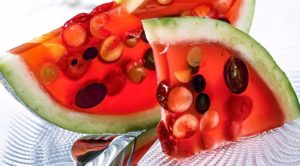
There are no useful substances in marmalade, if the lion's share of its properties is artificial. But more natural and modern counterparts have beneficial properties. There are several types of sweetness, depending on the chosen gelling agent:
- Fruit and berry - it is made on the basis of fruit and berry preparations in the form of puree.
- Jelly - is built on the basis of agar, agaroid or pectin gelling agent.
- Jelly-fruity - a combination of the two previous techniques.
The benefits and harms of chewing marmalade will be in its quantity - the more the child eats sweet, the more sugar in the blood, therefore, knowing the properties and possible harm, you need to dose the intake (after consulting a pediatrician). If the body does not perceive the properties and composition of the product, it is better to exclude it from the diet so as not to harm health.
There is pectin in apples, so with this property fruit and jelly products will be useful, tasty and will cheer you up.
The benefits of marmalade for women
It will be useful for the female body to get a dose of sweets that will not affect the figure. But that's not all:
- Cattle-based gelatin sweetness is good for hair and nails.
- It is also good for the skin with its plant oils and their properties.
- A grain fraction of acids will be useful for the functioning of the female reproductive system.
You should not overuse dessert for those who suffer from kidney failure. Some treats are based on chemical preservatives (to create flavor), and the properties of these elements can be harmful. Some properties can negatively affect your well-being.

Can marmalade be used during pregnancy and breastfeeding?
In the first and third trimester of pregnancy, admission to the diet of a young mother is allowed. You should choose a quality manufacturer that uses natural ingredients. In the second trimester, it is not recommended to eat foods containing acids and animal or vegetable fats. Their properties negatively affect the condition of the fetus.
If these are preservatives and artificial (chemical) components, the harm from them will only increase. In addition, “antibodies” are formed in mother's milk, which, due to their properties, interfere with the absorption of nutrients.
Since during pregnancy, the mother prepared the ground for the baby, in the first days or weeks of life it is not scary to eat a little sweet.
It is worse if the mother did not eat such foods during pregnancy, since during breastfeeding, milk can be saturated with all the properties of the constituent ingredients. Either this should be done before childbirth, or abstain until the baby is fed. With the introduction of complementary foods, the baby is still feeding on mom's milk, so you can vary the taste.

In the first three months it is better to avoid not only marmalade, but also other "temptations" of mass production. Marshmallow marshmallows, chocolate delights and chips are excluded from the diet, as their properties are not useful and can be harmful.When the baby grows up, you can enter any food that will not cause allergies or diathesis.
How and at what age to give marmalade to children
When a child is ready for a new meal, there are many different foods to offer. By the first year of life, he is ready to try fermented milk products, the benefits of which are obvious. Juices and fruit purees are also introduced.

During the period of complementary feeding, the baby learns the taste, but still loves sweetish milk. Marmalade is not harmful for a one-year-old baby, because his food enzymes are fully formed, the stomach and organs are functioning normally. The benefits of marmalade for children are ambiguous. If the baby constantly eats synthetic food, and not the sweets prepared by his mother, then subsequent stomach diseases are possible.
Is marmalade useful for losing weight
People who are on a diet can afford a product like marmalade. Its benefits lie in low calorie content, and it will not harm the figure. Of course, you should not replace the entire diet with only him or take snacks.
This is a dessert to be consumed at the same time every day. It is advisable to eat sweets before noon, since the body is at its peak. You should not combine it with other desserts, only with drinks. Berry-jelly marmalade is the best option for losing weight, since it contains the least vegetable and animal fats. Marmalade with a diet is consumed in the morning or before lunch.
Is marmalade possible for diabetes
Diabetics often eat sugar substitutes. It saves when there is too much of it in the blood. Diabetes of the first and second types is accompanied by low production of insulin, but the acquired type is the most "capricious", since people sometimes have to take insulin every hour. When he is not at hand, the situation is critical, you should have lollipops or jelly gummies on hand. They can be prepared at home, taking into account the needs of the person:
- Fruits (apple, pear, plum) peel and separate from the seeds.
- Cut into small pieces.
- Cook and darken.
- Then grind again in a blender and simmer in a pan.
- When the mass becomes gruel, add sugar or a substitute to taste.
- Pour into molds and cool.
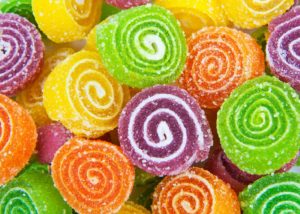
According to this recipe, fruit sweets will be obtained, which, due to the melted sugar, will keep their shape, but have plasticity. It is not worth adding gelatin, as it does not always hold the fruit together. You can diversify the recipe with cardamom, citrus and more. The use of marmalade on agar can only be if it is purchased in a store. At home, it is difficult to create healthy food without such components.
The use of marmalade for gastritis and pancreatitis
The use of jelly-type marmalade will be in the effect on the body of the substances that make up it. Jelly is prepared on the basis of natural fruit ingredients, juices, processed products.
The usefulness is high, but not overused. With diseases of the gastrointestinal tract, many adhere to a diet almost always. This is a limitation in acidic and pungent ingredients. Gastritis does not like spicy dishes, pancreatitis - fatty and salty. Marmalade will be useful only if it is made from natural ingredients. It can be used for diseases if the stage is chronic, but is in remission.
Acute pain indicates an "active" disease. In this case, diet and fasting are required. Pancreatitis does not react to jujube as well as gastritis. Since the second is a disease of the main organ, the first is a disease of the part of the subsidiary organ.
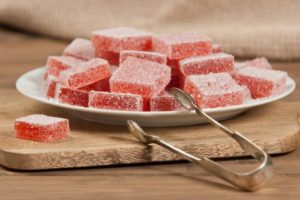
How much marmalade per day
There is no strict restriction on the consumption of marmalade.If you are not allergic to the constituent components, it is permissible to eat up to 300 g of marmalade. There won't be much harm, but you shouldn't combine it with carbonated drinks.
It can also be used as a filling or filling for cookies. Shop gummy bears melt well, give in to deformation and harden quickly, but after heat treatment they become more "rubbery" and sticky.
How to make homemade marmalade
To make delicious fructose marmalade, which will be useful for both adults and children, it is recommended to take natural products as a basis:
- Berries or fruits are taken and crushed to a state of gruel.
- Heated gelatin in a water bath.
- The fruit mass is poured into gelatin and mixed.
Further, the cooled mass is poured into molds and solidifies. You can store it in the refrigerator. Warm the dessert slightly to room temperature before serving.
Why marmalade is harmful: contraindications
The benefits of marmalade for the human body are not always the case, since harm is also present. If we talk about chronic diseases in the epigastric region, people are not recommended to use jelly-like substances. They trap toxins that are produced by the digestive system. If marmalade is sometimes useful to a healthy person, then it is better for a patient to exclude it, so as not to harm yourself.

How to choose and store marmalade
The benefits and harms of marmalade for human health cannot be based only on the composition. Since it must be stored in a dry, dark place, some qualities are lost if this rule is not followed. Benefit turns into harm as plant and animal compositions change.
Some ingredients without preservatives can cause stomach discomfort. You need to choose jelly marmalade - it is more useful, and the harm from it is less than from an analogue containing animal fats.
Conclusion

The benefits and harms of marmalade depend on its composition. This is food that, in principle, is not dangerous, as it contains jelly components and fruit fillers. This is not a medicine, so the benefits of marmalade for joints or skin are excluded. It will not harm it if you dose consumption. It will be useful only in the case of home cooking. Store-bought counterparts will not bring much benefit, although the properties are not so dangerous.

